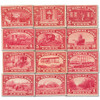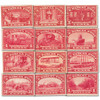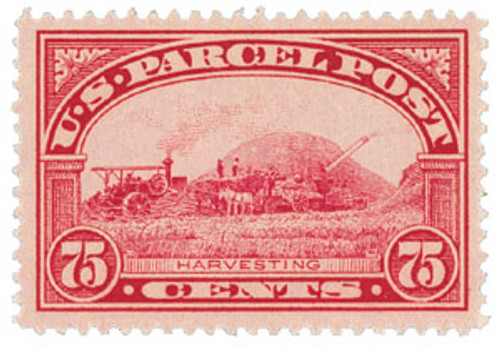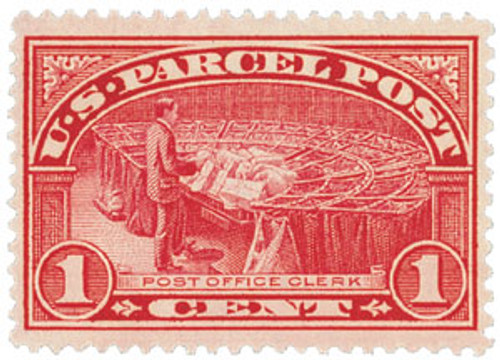
# Q1-12 - 1912-13 Parcel Post Stamps 12v
Get a Complete Collection of Parcel Post Stamps
Often overlooked by collectors – all twelve are expertly engraved with classic stamp designs we collectors love. The illustrations chronicle earlier days of mail delivery including different postal carriers and other important ways people earned a living. The best part is you can get the complete set without breaking the bank. Save time and money – get all twelve in one easy order!
In 1912, the U.S. Postal Department established its parcel post service for sending items weighing 16 ounces or more through the mail. The U.S. Post Office divides all mail into four classes, with parcel post making up the fourth class. Almost any type of merchandise can be mailed parcel post, including day – old chicks, baby alligators, and honeybees. Only items that could be dangerous to handle cannot be sent through the U.S. postal system.
Twelve stamps with various denominations were issued in 1912-13 to prepay the fourth-class rate. Although different vignette designs were featured, all twelve stamps used the same border and color, which caused a great deal of confusion for postal workers.
Less than a year later, the Postmaster General authorized ordinary postage stamps as valid for parcel post. Parcel post stamps were then made valid for all classes of mail and were used as regular postage until the supply was depleted. The 20¢ issue was the first stamp to picture an aircraft carrying mail, although by 1912, mail had been transported by air on numerous occasions.
Parents Mail Their Daughter
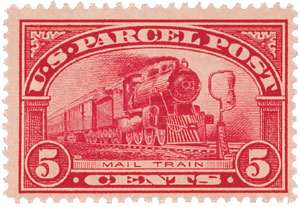
On February 19, 1914, parents in Idaho took advantage of the affordable Parcel Post rate to mail their daughter to her grandmother’s house.
A year earlier, the Post Office Department had initiated its Parcel Post service for fourth-class mail on January 1, 1913. Parcel Post service could be used for sending items weighing 16 ounces or more through the mail. The mail is divided into four classes, with Parcel Post making up the fourth class. Almost any type of merchandise could be mailed parcel post, including day-old chicks, baby alligators, and honeybees. Only items that could be dangerous to handle could not be sent through Parcel Post.

It wasn’t long after the new service began that parents found an interesting loophole. None of the regulations concerning parcel post prohibited the mailing of people, and other living beings were being mailed that way. In January 1913, Mr. and Mrs. Jesse Beauge of Glen Este, Ohio, sent their young son via Rural Free Delivery one mile to his grandmother’s. The parents paid 15¢ for the stamps and insured their son for $50. Later that month, a family in Pine Hollow, Pennsylvania mailed their daughter to relatives in Clay Hollow at a cost of 45¢.
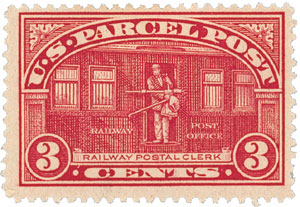
Then on February 19, 1914, five-year-old May Pierstorff’s parents in Grangeville, Idaho, wanted to send their daughter to visit her grandparents 73 miles away. They placed 53¢ in stamps on her coat and handed her over to the postal worker on the Railway mail train, who also happened to be a relative. Despite her safe delivery to her grandmother’s doorstep, once Postmaster General Albert S. Burleson heard her story, he officially prohibited postal workers from accepting humans to be mailed.
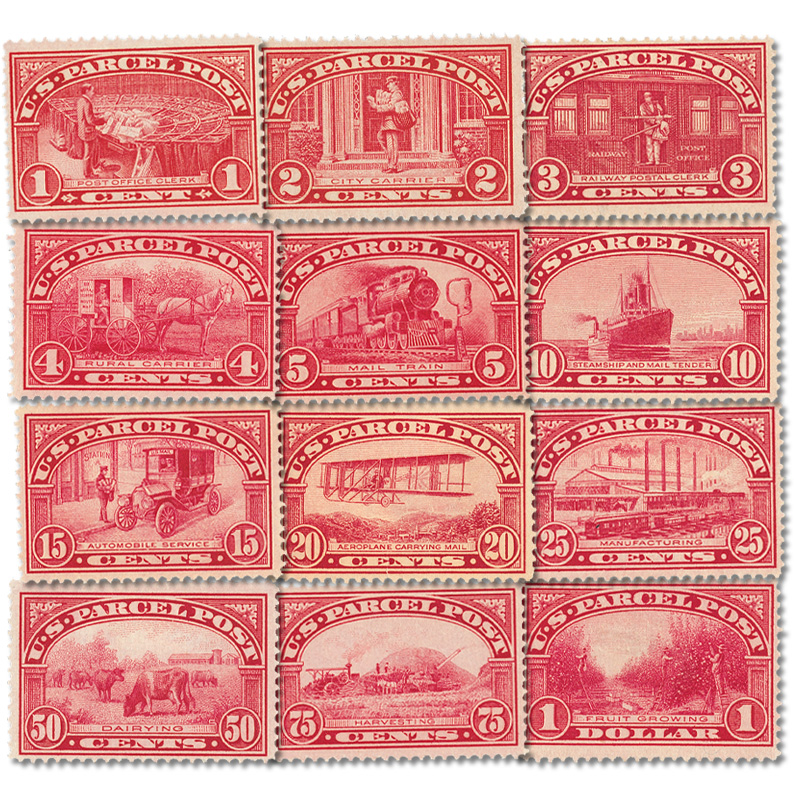
In spite of this, a woman mailed her six-year-old daughter 720 miles from Florida to Virginia the following year for 15¢. The last known instance of a child being mailed came in August 1915, when three-year-old Maud Smith was mailed from her grandparents to her sick mother in Kentucky. Even after this, some people attempted to mail children, but postmasters rejected their applications claiming they couldn’t be classified as “harmless live animals.”
Get a Complete Collection of Parcel Post Stamps
Often overlooked by collectors – all twelve are expertly engraved with classic stamp designs we collectors love. The illustrations chronicle earlier days of mail delivery including different postal carriers and other important ways people earned a living. The best part is you can get the complete set without breaking the bank. Save time and money – get all twelve in one easy order!
In 1912, the U.S. Postal Department established its parcel post service for sending items weighing 16 ounces or more through the mail. The U.S. Post Office divides all mail into four classes, with parcel post making up the fourth class. Almost any type of merchandise can be mailed parcel post, including day – old chicks, baby alligators, and honeybees. Only items that could be dangerous to handle cannot be sent through the U.S. postal system.
Twelve stamps with various denominations were issued in 1912-13 to prepay the fourth-class rate. Although different vignette designs were featured, all twelve stamps used the same border and color, which caused a great deal of confusion for postal workers.
Less than a year later, the Postmaster General authorized ordinary postage stamps as valid for parcel post. Parcel post stamps were then made valid for all classes of mail and were used as regular postage until the supply was depleted. The 20¢ issue was the first stamp to picture an aircraft carrying mail, although by 1912, mail had been transported by air on numerous occasions.
Parents Mail Their Daughter

On February 19, 1914, parents in Idaho took advantage of the affordable Parcel Post rate to mail their daughter to her grandmother’s house.
A year earlier, the Post Office Department had initiated its Parcel Post service for fourth-class mail on January 1, 1913. Parcel Post service could be used for sending items weighing 16 ounces or more through the mail. The mail is divided into four classes, with Parcel Post making up the fourth class. Almost any type of merchandise could be mailed parcel post, including day-old chicks, baby alligators, and honeybees. Only items that could be dangerous to handle could not be sent through Parcel Post.

It wasn’t long after the new service began that parents found an interesting loophole. None of the regulations concerning parcel post prohibited the mailing of people, and other living beings were being mailed that way. In January 1913, Mr. and Mrs. Jesse Beauge of Glen Este, Ohio, sent their young son via Rural Free Delivery one mile to his grandmother’s. The parents paid 15¢ for the stamps and insured their son for $50. Later that month, a family in Pine Hollow, Pennsylvania mailed their daughter to relatives in Clay Hollow at a cost of 45¢.

Then on February 19, 1914, five-year-old May Pierstorff’s parents in Grangeville, Idaho, wanted to send their daughter to visit her grandparents 73 miles away. They placed 53¢ in stamps on her coat and handed her over to the postal worker on the Railway mail train, who also happened to be a relative. Despite her safe delivery to her grandmother’s doorstep, once Postmaster General Albert S. Burleson heard her story, he officially prohibited postal workers from accepting humans to be mailed.

In spite of this, a woman mailed her six-year-old daughter 720 miles from Florida to Virginia the following year for 15¢. The last known instance of a child being mailed came in August 1915, when three-year-old Maud Smith was mailed from her grandparents to her sick mother in Kentucky. Even after this, some people attempted to mail children, but postmasters rejected their applications claiming they couldn’t be classified as “harmless live animals.”



